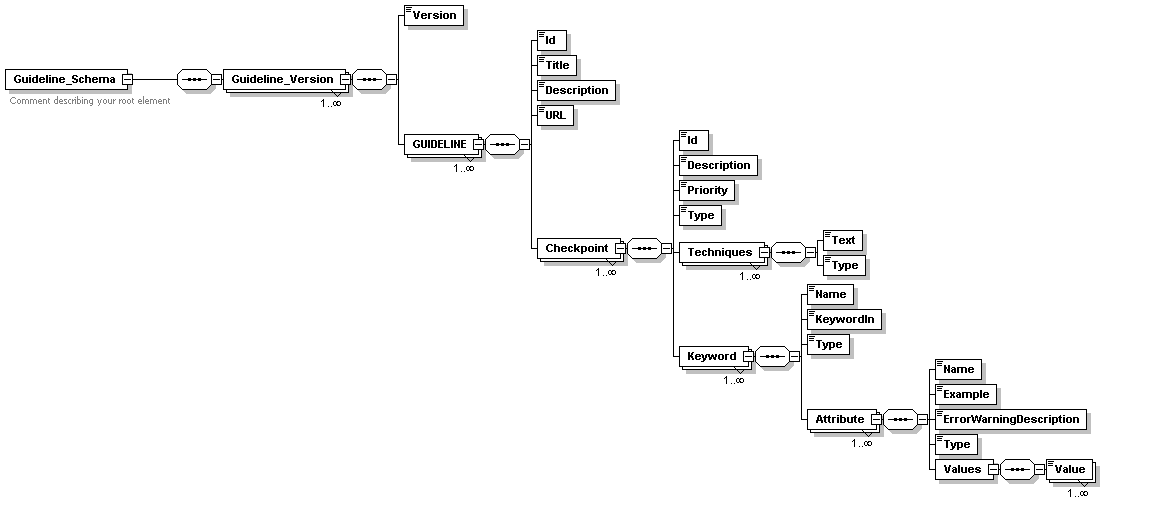A Web Service, with the name of EvalIris, has been designed to evaluate the accessibility of HTML pages is presented. The analysis is based on easily updateable accessibility criteria, making this tool able to easily incorporate new sets of guidelines and updates. It can be used both, as an on-line stand-alone application, and as a web service. In this last case, it can be used by any other application to perform accessibility analysis and, in this way, to extend its features.
Web Accessibility, Web Service, XML Schema.
The Web Accessibility concept refers to the possibility of accessing any web content by anyone regardless to circumstances such as impairments, platforms, devices, browsers, etc. This is a very wide idea that must be clearly specified in order to be able to verify its application. For this reason, some organizations have issued web accessibility criteria as sets of guidelines. Currently, the most relevant and universally accepted guidelines are the ones produced by World Wide Web Consortium/Web Accessibility Initiative (W3C/WAI) [6], called Web Content Accessibility Guidelines (WCAG) [4].
Even if the criteria to verify if a web site is accessible are currently quite well defined, it is difficult to verify whether they are satisfied by a web site. There are two main reasons: the size of many web sites, with thousands of HTML code lines, and the difficulty for non-professionals to interpret, understand and verify some of the guidelines. For this reason, a number of tools tools to facilitate web contents accessibility evaluation, such as Bobby [2], TAW [5], A-Prompt [1], etc., have been developed. These tools are based on specific sets of guidelines as Section 508 [4] and WCAG 1.0.
Here we present an automatic accessibility evaluation tool: EvalIris, where accessibility criteria are easily updatable to allow for the rapid incorporation of new accessibility guidelines. This tool has been developed within the “IRIS” European project [3]. More information on the tool and a fully operating prototype can be found in http://www.sc.ehu.es/acwbbke/EvalIris.html.
TFrom the analysis performed, it is possible to conclude that the accessibility knowledge included in the WCAG guidelines can be expressed in terms of HTML elements (i.e., tags, attributes). This allows for the creation of a well defined structure to specify accessibility guidelines, to be used as accessibility knowledge repository by the evaluation tool.
Therefore, the easily updatable feature of EvalIris is achieved by expressing the accessibility guidelines in a well defined XML format. For this purpose, a XML Schema has been designed (Figure 1). As seen, the proposed XML Schema follows this pattern: each guideline is defined as a list of checkpoints expressed in HTML tags and their attributes.
This scheme allows for the easy accommodation of new guidelines that adjust this structure into its database. Nowadays, this translation must be carried out manually but a tool to assist the designer to accommodate new guidelines to the XML scheme is being developed.

Figure 1. XML Schema for accessibility guidelines
Different types of techniques have been used when implementing this Web Service, all based on Java technology. The Web Service runs on a Tomcat server and SOAP (Simple Object Access Protocol) technology is used in the communications, while the core of the system is implemented in Java.
In order to perform the accessibility evaluation, the system interacts with a native XML database (Xindice) where the guidelines transformed in the previously explained XML structure are stored.
The algorithm directly evaluates the mark-up of the web page. EvalIris can perform this in two ways: on the one hand, it allows for the accessibility evaluation of a remote web page starting from its URL and, on the other hand, the mark-up code of then web page can be up-loaded into the EvalIris page in order to be analysed.
When the mark-up is available, it is divided into its HTML components (image, table, header…). Afterwards, the accessibility of each component is verified separately. In order to perform this verification, EvalIris has to retrieve accessibility information from the native XML database, taking the accessibility of each component into account.
A number of these accessibility requirements contained in the database are automatically verified by EvalIris, however, there are others that need manual verification. This is because the translations to HTML tags of certain guidelines and checkpoints are hardly attainable. Therefore, if a component does not conform to any automatically verifiable accessibility requirement, an Error will be produced whereas, if this verification requires manual checking, a Warning will be produced. In this way, a set of Errors and Warnings is produced and collected in the final report compiled by the system. This report is also returned in XML format.
The entire process can be seen in Figure 2.

Figure 2. Evaluation process.
The experience acquired in the development of EvalIris shows that it is possible to express diverse sets of guidelines through a well-defined XML structure that has been designed. In addition, EvalIris has the added advantage that it can be invoked by any application connected to Internet, independently of the programming language and the platform, due to the fact that it has been implemented as a Web Service.
In the future, we will produce a tool that will assist the conversion of the accessibility guidelines into their related XML structures. In addition, we are working on a tool to assist the designer in the repairing of non- accessible web pages.